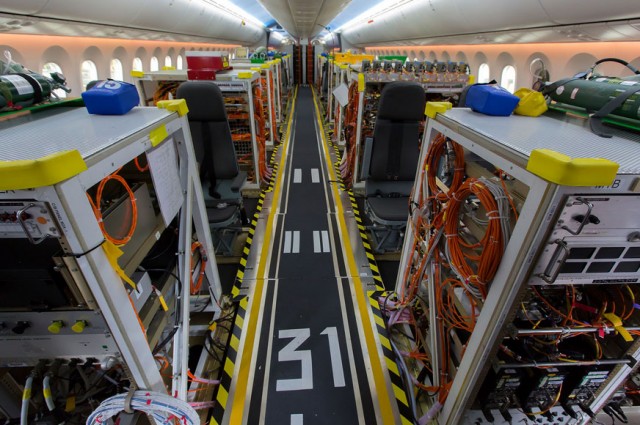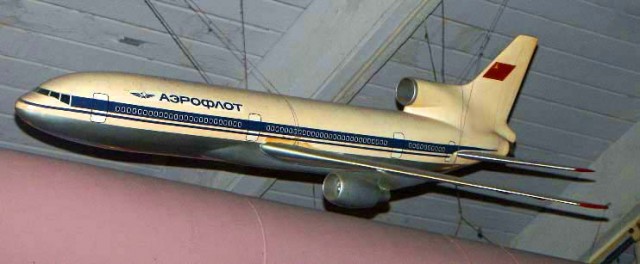
HI RES IMAGE (click for larger). JAL’s Boeing 787 Dreamliner taking off at Paine Field – Photo: Boeing
Last week, Japan Airlines announced that it will begin Boeing 787 service to Vancouver International Airport (YVR) on Monday, February 3, 2014. This will be the first scheduled arrival of a Dreamliner at YVR.
The JAL 787-8 will serve the YVR to Tokyo Narita (NRT) route, and will initially fly once per week on Mondays. Daily service will be in place by March.
We expect to see additional Dreamliner service at YVR this year, most noteably with Air Canada’s introduction of their 787-8 later in the spring. AC’s first of their 37-aircraft order, LN160, is to be registered as C-GHPQ and is currently in Position 2 of the Final Assembly Line at Boeing Everett.

Photo of WN 3014, evacuated on the airfield at the wrong airport! – Photo: Scott Schieffer
Details are still coming in, but according to @scottDallasTX and other media sources, Southwest Flight 3014, from Chicago (Midway) landed at the wrong Branson, MO airport this evening (cause there are tons of Branson airports). Again, details are coming, but it appears they landed at the College of the Ozarks airport (PLK), with only a 3700′ runway. Does anybody know – is that long enough for a 737 t0 take off?
This is strangely reminiscent of the situation last month where a Boeing 747 Dreamlifter, operated by Atlas Air, landed at the wrong airport in Wichita. When fields are in close proximity, mistakes can happen.

Tweet from a passenger on WN 3014 – via Twitter
According to Scott, the landing was efficient, but scary.
More to follow!
Update (7:20PM PDT): It looks like the Southwest Boeing 737-700 CAN take off with this limited runway, albeit likely empty. Expecting a big day tomorrow for internet viewers? (H/T to Managing Correspondent @BigMalX).

The passenger section of the Boeing 787-9 Dreamliner – Photo: Nick Young | AusBT
Excerpt and photo used with permission from Australian Business Traveller…
Step inside Boeing’s 787-9 Dreamliner ZB002 on this exclusive tour of what is only the world’s second stretched Dreamliner before large-scale production begins ahead of its debut in July with worldwide launch customer Air New Zealand.
Long before any new commercial aircraft takes to the skies with paying passengers on board, manufacturers such as Airbus and Boeing carry out an exhaustive series of flight tests with specially-build aircraft.
The Boeing Dreamliner 787-9, which carries the ZB002 model number, is part of that process for this larger, longer-range version of the original 787-8 Dreamliner.

The “Engineering Class” seats on the 787-9 Dreamliner. Notice the runway design on the floor – Photo: Nick Young | AusBT
The second of three 787-9s dedicated to the new plane’s test program, ZB002 last week flew non-stop from Seattle to Auckland ’“ marking the 787-9’s longest flight, at just under 14 hours ’“ and is now visiting Alice Springs, in the centre of Australia, to undergo extensive heat testing under the sizzling summer sun.
So what’s it like inside of of these special test aircraft?
See many more GREAT 787-9 interior photos via AusBT…

I bet most people thought this was a joke! Photo: Chris Sloan | Airchive.com
The 1970s were a time of economic malaise for the west. Weirdly, the Soviet Union was chugging along at its own egregious and bizarre pace, and Soviet air travel needs had never been more pressing. Millions of Warsaw Pact and Soviet citizens needed to shuttle around the Iron living room. In fact, Aeroflot celebrated its hundred-millionth-passenger year in 1976. This called for larger aircraft. Engine technology issues were holding up Ilyushin’s domestic design, which we now know as the mostly-extinct IL-86.
The program to which the IL-86 stemmed from was formally known as the “aerobus”. The IL-86 was not supposed to be the only aircraft of the family of short, medium, and long-haul indigenous widebody aircraft.

Believe it or not, Tupolev almost built a similar aircraft (but widebody) to the Dassault Mercure. Photo: Alain Durand
Tupolev had stepped up to offer the Tu-184, an aircraft that was similar to a twin-aisle Dassault Mercure. Thankfully, at the time of its inception Andre Tupolev was still alive. He took one look at it and decided that the company should not waste any resources on what he was sure would be nothing but a reputation-wrecking disaster. Not that Tupolev was immune to civil aviation failures, they are simply beyond the scope of this article. They were also, usually, swept under the rug and blamed on Myashischev (a competing design bureau).

My travel map for the USA… Could I tick an extra state off that list? – Image: TravBuddy.com
Each year I set some travel goals for myself; that way throughout all the craziness that may happen during the year, I have a guideline of the things I want to see or do. OshKosh was on my list, as well as my trip home to Australia back in April. I was able to complete those and needed some additional challenges.
I realized fairly late in the year, after returning from New Zealand, that I had left a goal off my list. Being new to living in the USA, I want to see more of this country that I now call home. I had set a goal to add at least one more state to my list of those visited (I was sitting at 42 and I decided that I wanted to make it to at least 43 by the new year).
My colleagues at Airline Reporter found out about this and thought they would have a bit of fun with it. I could check off a state, but I had to do it for less than $100 and make a whole weekend out of it. I accepted the challenge.







